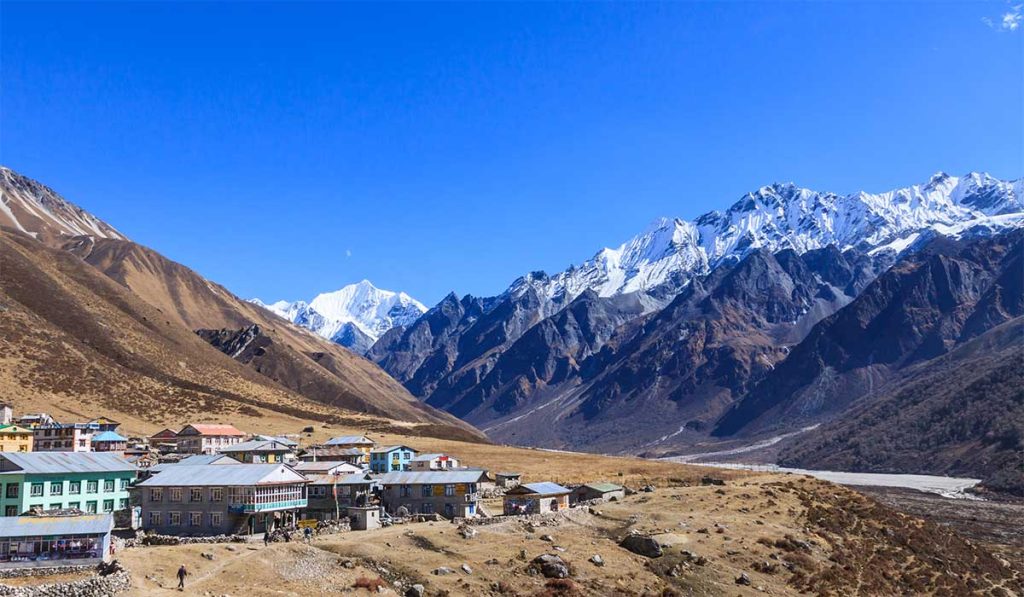
No nature lover can be unaware of the world’s highest peak, Mt. Everest. Standing at 8,848.86 m above sea level, this majestic peak is a living myth, where ancient rocks once buried beneath the sea now roar above the sky, into space.
Undoubtedly, the rewards of visiting Everest are unmatched by any peak or trek. However, the rewards expectedly come with several challenges, tough enough to eat a large number of trekkers yearly.
Popular as Sagarmatha in Nepal and Chomolungma in Tibet, Everest has a deep spiritual and cultural significance for the locals. There are stories to be uncovered. If you are curious about these stories, routes, cost or history of Everest, this blog gets you covered. Find all these details and know what it’s really like at the Everest Base Camp by reading the article.
Everest Quick Facts: Essential Information About the Highest Mountain
- Mount Everest Height: 8,848.86 m (29,031.7 ft)
- Location: Nepal–China border (Mahalangur Himal Subrange)
- Range: Himalayas
- First ascent: Sir Edmund Hillary (New Zealand) & Tenzing Norgay Sherpa (Nepal)
- Coordinates: 27.9881° N, 86.9250° E
- Fatality rate: 1% per attempt
- Permit count: 3-4
Mount Everest History
A long time before Everest became the ultimate mountaineering destination, it was just a sacred, remote, untouched, and unmapped giant. It was called Pandrauchuli (Peak XV) by the locals, and trekking or climbing there was unimaginable.
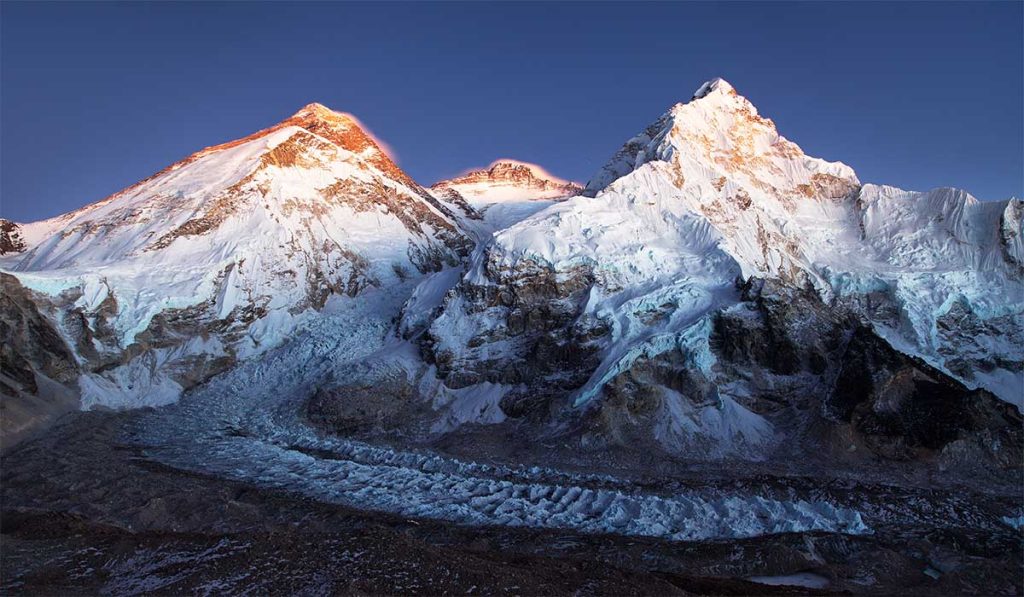
Time passed, and the year 1953 gifted the first successful climb of the vintage Mount Everest. It was a Sherpa blood Tenzing Norgay Sherpa, and the New Zealander legend- Sir Edmund Hillary, whose dedication and hard work crafted the way to the Everest Summit. However, it took centuries for the journey of climbing to gain this popularity due to several failed Everest expeditions and the nation’s instability.
Mount Everest Name Origin: What Sagarmatha and Chomolungma Mean
Mount Everest had been named differently by different ethnicities. Each of the ethnicity reflects a different historical mythology and story.
Who was George Everest?
In 1865, the name “Mount Everest” was officially given. The Royal Geographical Society in London gave the name after a British surveyor in India, Sir George Everest. The ironic part is that George Everest had never actually seen the mountain, and also contradicted the naming in his name.
At that time, British cartographers were mapping the Indian subcontinent and identifying large peaks using a system of “trigonometrical points”. When Peak XV was found to be the tallest, they decided to name it after Everest, despite local names.
Sagarmatha: “The Forehead of the Sky”
In Nepal, Mount Everest is known as Sagarmatha, a name that was introduced to reflect national identity during the 1960s. Roughly translated from Sanskrit, it means “the forehead of Sky.”
Although the term does not appear in ancient Nepali writings, it has a symbolic value, connecting the summit with divine height and astronomical appearance. For Nepalis, Sagarmatha is more than just a peak; It is a living spiritual landmark that is honored through prayer, flags, and mountain deities.
Chomolungma: ” Goddess Mother of the World”
In Tibet, Everest has been called Chomolungma for centuries, long before any Western campaign ever reached it. The name, Chomolungma, is translated to “Goddess Mother of the World” and is deeply rooted in Buddhist cosmology.
Locally, Tibetans and the Sherpa community see Everest as a powerful deity. The climbers are still encouraged to participate in the puja ceremonies in the base camp to ask the goddess for a safe journey – a tradition that is even honored by foreign mountaineers.
Why does the name still matter?
Today, “Mount Everest” is globally recognized, but many climbers and protectionists now use Sagarmatha and Chomolungma to honor the mountain’s original identity.
For the locals, these names are not just labels – they represent a relationship with the land, a form of respect for the sacred, and a reminder that it was valued long before it was conquered.
How was Mount Everest Formed? Geology of the Himalayan Giant
Plate Tectonics: India hits Eurasia
- About 50 million years ago, the Indian tectonic plate began to collide Eurasian plate.
- Because of this collision, the Himalayas were formed as the crust crumbled, folded, and uplifted.
- Mount Everest is the highest point formed from this tectonic collision
Unusual Rocks Found in the Everest region: Reason Explained
- Mountain Peak: Regardless of its enormous height, the top of Mount Everest is made up of marine limestone and Sedimentary rock. The reason is simply the collision discussed above.
- Near the Summit: Rocks that are formed on ancient sea beds, like marble and Limestone, are found mostly in the Everest region. These rocks still consist of sea animals’ fossils, which prove that Everest was once submerged in the sea.
- Deeper Inside: Metamorphic rocks such as schist and gneiss are found deeper in the mountain. These types of rocks are formed due to excessive heat and pressure deep inside the crust. This layering suggests that Everest was pushed upwards from the crust.
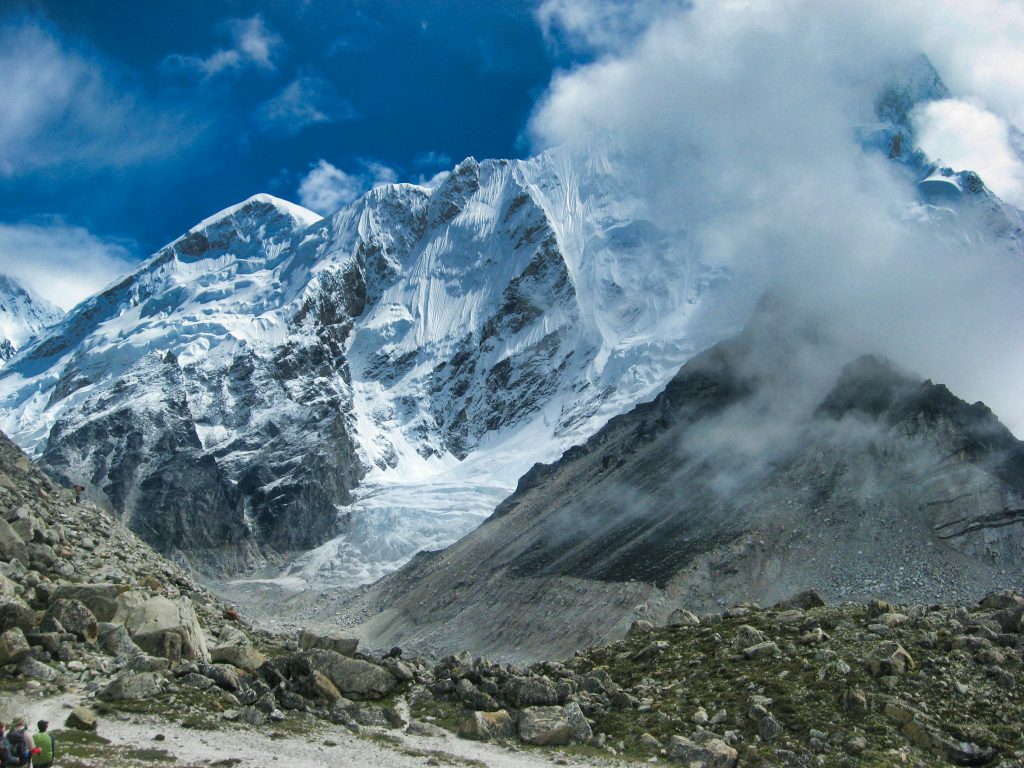
Photo by Nathan Langer on unsplash
How does Everest still grow each year?
It sounds shocking, but Everest indeed grows each year. The Indian plate hasn’t stopped yet. The plate still pushes itself towards the north (approx. 5 cm per year). As a result, Everest grows about 4-10 mm per year, although the speed varies slightly.
At the same time, glaciers erosion, and the air tries to wear it down. Moreover, large earthquakes (such as the Nepal earthquake in 2015) in the region can temporarily affect Everest’s geology, either increasing its height or reducing it slightly.
Everest Base Camp: Everything You Need to Know
The Everest Base Camp is regarded as the starting point for the mountaineers aiming to summit Mt Everest. But besides that, it is an iconic trekking destination in itself. Located at a height of 5,364 meters (17,598 feet) on Everest’s southern side (Nepal), it offers a lifetime experience by combining the mesmerizing Himalayas views with the Sherpa culture and a sense of adventure.
Where Is Everest Base Camp?
The Everest Basecamp lies in northeastern Nepal’s Khumbu region, within Sagarmatha National Park, a UNESCO World Heritage site. It sits at the foot of the dramatic Khumbu Icefall, the first major obstacle for climbers.
- Country: Nepal
- Region: Khumbu Valley, inside Sagarmatha National Park
- Coordinates: 28°0′26″N 86°51′34″E
- Distance: About 130 km round trip
- Difficulty level: Medium to high
Trekking to Everest Base Camp: The EBC trek
Everest Base Camp Trek is considered one of the most prestigious and scenic treks in the world. It usually takes a 12-14-day planned trip, depending on speed and the acclimatization route. Stunning landscapes, cultural immersion, and a rewarding sense of achievement perfectly balance the challenges and rewards of the EBC trek.
How to reach Everest Base Camp?
For most, the journey starts with a small flight from Kathmandu to Lukla (2,860 m), which is known for its dramatic landing strip carved into the mountain. From Lukla, the trail takes you through a series of fantastic villages and landscapes.
The main stops with Trek:
- Phakding: The first overnight stop after Lukla, which is settled along the Dudh Koshi River.
- Namche Bazaar (3,440 m): Popular as the heart of the Khumbu region and a large point of acclimatization.
- Tengboche: Famous for Tengboche monastery, the largest in this region, with beautiful scenes of Ama Dablam.
- Gorak Shep: The last village before reaching EBC. Trekkers often climb the Kala Patthar (5,545 m) from here for the best panoramic scene of Mount Everest.
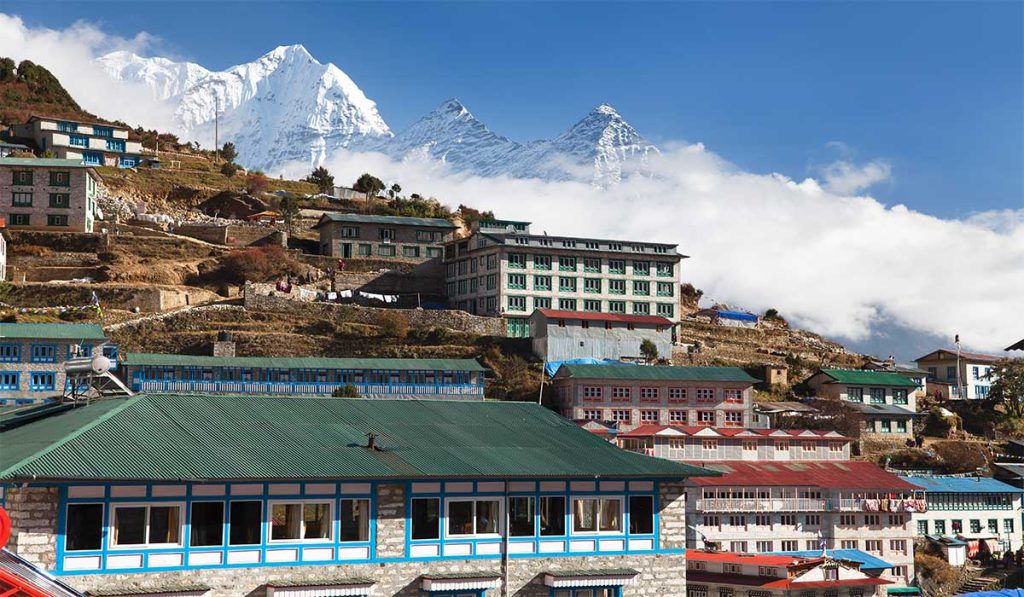
Why is the Everest Base Camp trek special?
Reaching the Everest Base Camp is a dream adventure for nature lovers from all over the world. More than just taking you closest to Everest, it helps in the discovery of yourself through a series of tests (from strength to mentality) in every step.
Highlights:
- Close-up views of Himalayan giants, including Everest, Lhotse, Nuptse, and Ama Dablam.
- Lively Sherpa culture, where trekkers experience hospitality, spirituality, and tradition through tea houses, prayer flags, and monasteries.
- Retracing the footsteps of Sir Edmund Hillary, Tenzing Norgay, and the countless other early pioneers of Mount Everest.
- Trekking across the Swaying Suspension Bridge, glacial rivers, and alpine forest with true high-altitude wilderness.
The best time to visit Everest Base Camp (EBC)
Choosing the right time to trek to the Everest Base Camp is necessary for both safety and experience. While the trail is technically open throughout the year, the best time to travel to EBC is during the pre-monsoon (spring) and post-monsoon (autumn) seasons.
Spring Season (March to May) – Best General
Spring is considered the best season to embark on the Everest Base Camp trek as this period provides the most stable weather with clear skies. The blooming Rhododendrons color the forest red, pink, and white.
However, it is also the busiest time for trekking as trekkers from all around the globe wait for this perfect time. This results in the EBC becoming a vibrant hub of tents during this time.
Temperature at Day: 5°C to 15°C (41°F to 59°F)
Temperature at Night: -5°C to -15°C (23°F to 5° F)
Autumn season (September to November)
Autumn is another good time to trek to the Everest Base Camp. The Crystal-clear Mountain View’s dry trails and stable weather make this season a popular trek.
The crowds in post-monsoon time are not as large as those in the spring, which makes it an ideal time for those who hate overcrowding.
Temperature in Daytime: 5° C to 12° C (41° F to 54° F)
Temperature at night: -5 °C to -10 ° C (23 ° F to 14 ° F)
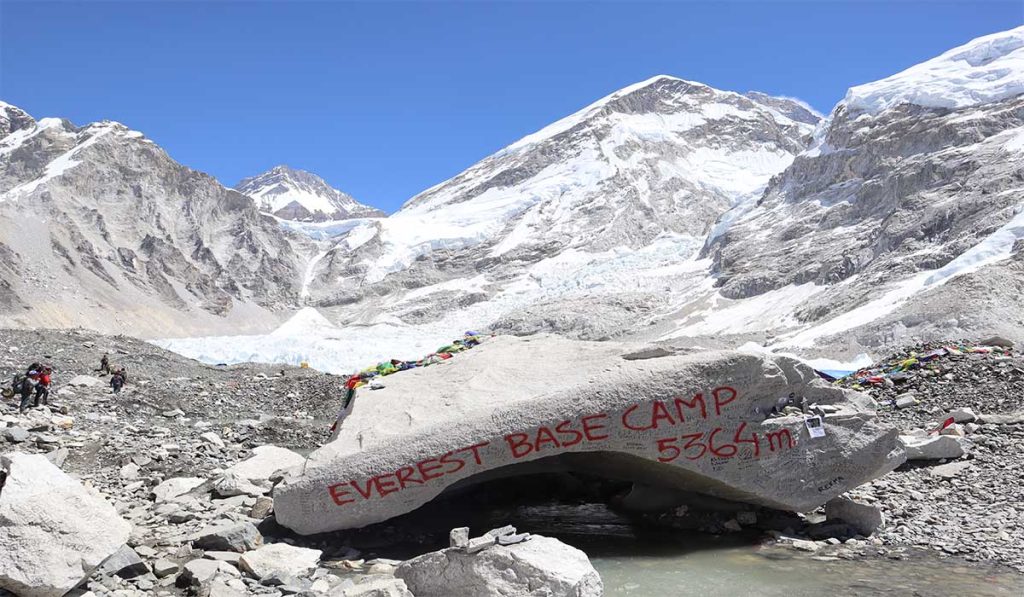
Monsoon Season (June to mid-September)
During monsoon, powerful rain is likely to cause landslides and delays. So, if you are willing to trek in such a time, safety is your top concern. Moreover, the trails are dirty, and the mountain views are unclear due to fog. And if you don’t like leeches, it can be more troublesome.
Temperature in Day: 0°C to 18°C (50°F to 64°F)
Temperature at Night: 5°C to 10°C (41°F to 50°F)
Winter (December to February)
Facing the cold is a major challenge at this time. Winter brings heavy snow and ice that may block the way, making the region of the trail lonely during this period. It’s only preferred by experienced trekkers with full preparation. So, to experience the solitude in the world’s most popular trekking region, you must be ready to face harsh conditions.
Temperature: -10°C to -20°C at night
Mount Everest Expedition: Explained
Everest Climbing Routes: South (Nepal) vs North (Tibet)
Mount Everest can be climbed from two sides- the Nepal side (Southern) and the China side (Northern), each providing unique and thrilling adventure. Here is the details on Mount Everest North route vs South route.
Southern Route to Everest (Nepal Side)
It is the most popular and commonly used route, which was first climbed in 1953 by Edmund Hillary and Tenzing Norgay.
- Base Camp (5,364 meters) – Reached by trekking from Lukla to the Khumbu valley.
- Khumbu Icefall – The first major obstacle that climbers face after moving up from the EBC. It’s a dangerous, steep shifting glacier with deep cracks and massive slabs of ice known as seracs.
- Camp I (6,065 m) – Camp I lies over snowfall, in western CWM.
- Camp II (6,400 m) – Camp II is situated at the base of the Lhotse face.
- Camp III (7,200 m) – Camp III of Everest is present on the steep Lhotse face.
- Camp IV (7,950 m) – Camp IV lies in the “Death Zone” in the Southern Col.
- Summit (8 848,86 m) – Via the Southeast ridge and Hillary Step.
Benefits of Climbing Everest Through the Southern (Nepal) Route:
- More established support, like rescues, guides, and infrastructures
- Scenic approach through the Khumbu Valley
- More climbers on the route
Challenges of Climbing Everest Through the Southern Route
- Khumbu snowfall is very dangerous
- Overcrowded during the peak season

North Route to Everest (The Tibet route)
The route was first climbed by a Chinese team in 1960. Technically, this route is less steep but logistically more difficult, which is the reason it meets fewer climbers.
- Base Camp (5,150 m) – Accessible by road
- Advanced Base Camp (6,500 m) – The camp I.
- North Col (7000 m) – This point is the beginning of the steep sections.
- Camp II (7,500 m) – Reached after 500m of technical climb.
- Camp III (8,300 m) – Right below Northeast Ridge
- Summit (8,848.86 m) – Reached through the exposed Northeast Ridge
Benefits of Climbing Everest through the Northern (China) Route
- No life-threatening icefall like Khumbu Icefall
- Comparatively less crowded
- Base Camp is reached by road
Challenges of Climbing Everest Through the Southern Route
- The northern route is colder and windier
- More technical rock section
- Chinese/Tibetan permits are more limited
Best Time to Climb Everest: Weather Windows and Seasonal Risks
Climbing Everest is not just about strength and skill – it’s about timing as well. There is a specific time to climb the Everest and most follow the same.
The Peak Climbing Season- Spring
April to mid-May is considered to be the perfect time for climbing Everest. The jet stream shifts to the north at this time which reduces the wind speed. Although the temperature is still too low, the wind and weather are in their most stable state, which aids a safe summit push.
However, Spring, being the perfect season, has to withstand the visit of thousands of trekkers in a very short period of time. Due to this, Everest often faces the harsh problem of overcrowding, which is very challenging to cope with.
The Post Monsoon Climb- Autumn
Even though Autumn is one of the best trekking seasons, climbing Everest is harder than in spring due to colder temperatures and snow accumulation. Mostly experienced mountaineers only attempt this time. So, planning to climb Everest this season without prior experience could be a bad idea.
Autumn, however, brings one of the best views of the year in the Everest region. The sky is crystal clear after the monsoon rain, and the Himalayas are in their most royal state. Furthermore, the trail isn’t crowded as well. Thus, these all are the reason Everest is climbed despite the challenges.
Why avoid the Winter and Monsoon Season?
Monsoon brings heavy snow, muddy trails, and frequent avalanches, and Winter brings extreme cold, powerful jet streams, and ice buildup, which makes this time irrelevant to climb Everest. Attempting it, despite the challenges, can be risky, especially if it’s your first time climbing Everest. Have a clear understanding of the weather and keep updated. The climb can be temporarily closed due to the damaged trail.
Why is the Summit window short and crucial?
Before understanding the Summit window, you should know about the ‘Death Zone’. The Death Zone indicates the areas above 8,000 m. At such altitude, human existence is severely limited. This makes moving above it very cautoious.
The short period of favorable weather when ascending from the Death Zone to the Summit is called the Summit window. The time period is often a few days long, indicated by circumstances like:
- Wind speed below 30-40 km/h.
- The temperature rises slightly.
- The risk of storms is low.
Having failed to ascend to the top during the Summit window means returning back entirely.
The Jet Stream
Jet Streams are the fast-flowing air currents at high altitude that encircle the Globe, typically moving from west to east. During the jet stream, the wind shockingly travels at a speed of 100+ miles per hour, which is insane.
When the jet stream shifts, climbers get a short break in the wind – the Summit window. If it returns quickly, it can cause violent winds, frostbite, and whiteout, even blowing climbers off the mountain.
Role of Oxygen on Everest: Why Most Climbers Can’t Go Without It
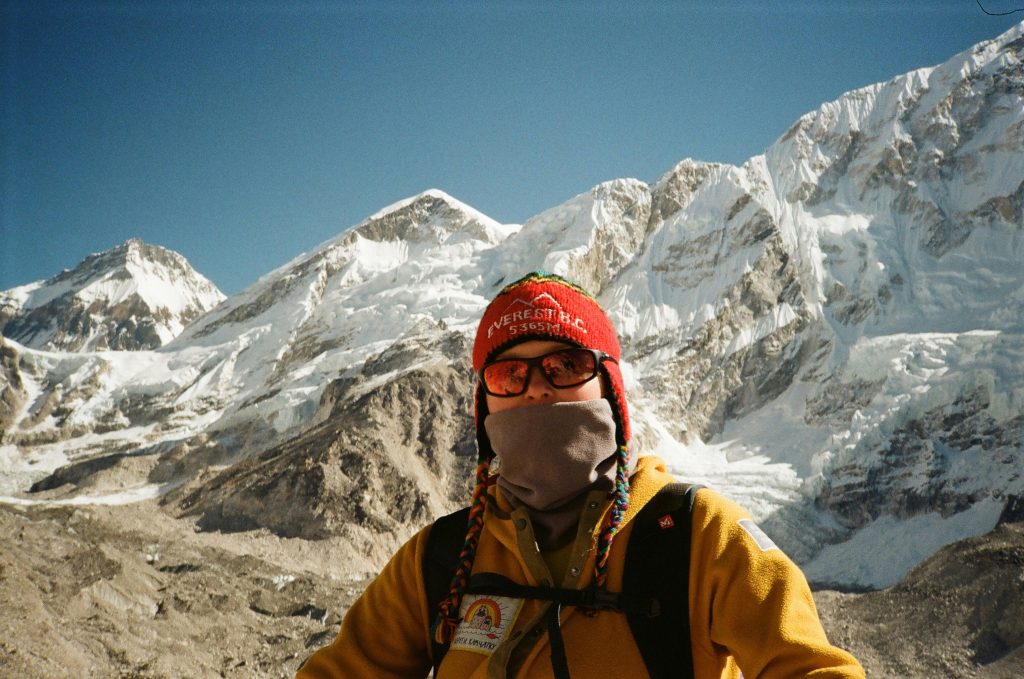
Photo by Marina Zvada via upsplash
How do oxygen supplements work on Everest?
At Everest, climbers meet with extremely thin air, especially over 8000 meters. At this height, the oxygen level is only one-third of that at sea level. To help the body function in this low-oxygen environment, climbers have to carry oxygen with them. This oxygen is stored in a light cylinder and is given to the body through oxygen masks and regulators. Oxygen helps to reduce fatigue, prevent altitude sickness, and improve the possibility of survival during the summit.
Types of oxygen systems used by climbers
There are two common types of oxygen systems:
- Continuous flow system: These provide a stable stream of oxygen regardless of the mountain climber’s breathing pattern. They are easy to use, but the oxygen is used quickly.
- Demand systems: This system provides oxygen only when climbers inhale. They retain oxygen and are more effective, but are a little more complex.
Climbers have to carry 2 to 3 oxygen cylinders with them for the summit day, depending on the weather and speed.
Risk of oxygen deficiency at great height
Running out of oxygen or use of deficient units on the Everest can have a serious consequence:
- Hypoxia: A condition where the body does not get enough oxygen, causing confusion and poor coordination. This is one of the most common and most dangerous challenges at Everest.
- Altitude sickness: The higher you go, the greater the risk of altitude sickness. It can occur to anyone at any time, obstructing the entire expedition. This is why the proper acclimatization is extremely crucial. Altitude sickness is mainly of three types:
- Acute Mountain Sickness: The most common form that is nearly unavoidable for first-time climbers. Headache, nausea, dizziness, vomiting, and fatigue are some of its symptoms.
- High-Altitude Pulmonary Edema (HAPE): It is a condition caused by a change in pressure. This makes accumulates fluid in the lungs of the victim and result in a fatal condition. Shortness of breath even at rest, persistent cough and chest tightness are some of its major symptoms.
- High-Altitude Cerebral Edema (HACE): This occurs at a greater height due to oxygen deprivation to the brain. In this condition, the brain gets swollen and climbers even get hallucinations. Other symptoms include confusion, altered mental state, and even coma. This is a medical emergency at Everest that must be treated immediately.
- Risk of death: Without supplementary oxygen, the risk of death related to height increases significantly. That’s why you must be prepared enough to face any emergency.
Famous climbers who summited Everest without oxygen
Only a few mountaineers have succeeded in reaching Everest without oxygen:
- Reinhold Messner (Italy) and Peter Haller (Austria): In the year 1978, Reinhold Messner and Peter Haller shocked the entire world by achieving this impossible task. Before, it was believed that withstanding the Death Zone without artificial oxygen was impossible for humans.
- Ang Rita Sherpa (Nepal): Ang Rita has climbed Everest 10 times without oxygen. This is unsurprisingly the world record for climbing Everest most times without oxygen.
- Erhard Loretan (Switzerland): Erhard Loretan is the only climber to summit all fourteen 8000+ mountains in the world without an oxygen supplement.
These climbers had extraordinary physiology, acclimatization, and experience, making their work mythological.
How to Prepare for Everest: Training and Fitness Requirements
Whether you are going to Everest Base Camp or trying a full summit of Everest, the preparation is all. This section shows what training you need to trek to the Everest Base Camp and what additional training you need if you are aiming at the world’s highest peak.
Everest Base Camp Trek Preparation (2025)
The EBC trek is a high-altitude but non-technical trek that reaches 5,364 meters. You do not need climbing skills, but you must be physically in shape and mentally prepared. Here are the training tips for Everest Base Camp:
Cardiovascular Fitness
- 4-5 Cardio sessions per week (hiking, incline walking, cycling)
- The purpose is to build endurance for trekking 6-8 hours per day
Legs and core strength
- Exercises like squats, lunges, and ladder climb
- The purpose is to trek with a loaded backpack (5-10 kg)
Flexibility and recovery
- Stretching and yoga sessions
- Very important in the trek
Mental preparation
- Expect cold, basic lodgings and fatigue
- Mental strength and flexibility are everything in the trek
Height Preparation
- Adjusting to altitude by reaching the highest place possible. If possible, consider using an altitude training mask or hypoxic tent.
Preparation for Everest Climb
If you are going beyond the base camp to climb Mount Everest, your workout should include everything above, as well as advanced physical, technical, and mental preparations as follows:
Full Body Strength
You will need to build your load-bearing capacity as you’ll need to carry a heavy backpack with oxygen cylinders at such an altitude.
- Exercise with heavy packages (15-25 kg) on stairs or trails (best)
- Add deadlifts, sled pulls, and high-climb
Technical climbing skills
It is very important to learn the technical skills beforehand to avoid confusion on the journey.
- Learn to use crampons, a harness, and an ice axe
- Practice rope techniques, ladder crossings, and crevasse rescue
Oxygen- and altitude simulation
- Exercise with high-altitude systems or hypoxic tents
- Climb preparatory climbs (eg, Island Peak, Aconcagua, Denali)
Mental endurance for extreme conditions
- Be familiar with cold exposure, long solo hiking, and sleep deprivation
- Prepare yourself for several weeks in the “Death Zone” and wait out storms
Everest Climbing vs EBC Trek Costs and Permit Fees: Full Breakdown for 2025
Whether you consider the Everest Base Camp (EBC) Trek or the Full Everest Summit campaign, it is necessary to understand the cost difference. Here is a detailed breakdown comparing the cost of equipment, guide, oxygen, and hidden fees:
Everest Base Camp Trek Cost (2025)
Reaching the Everest Base Camp is a great experience, once in a lifetime for most. However, it’s important to understand the expenses in each stage for an effective budget plan. Here’s an overview:
Total cost: $ 1,200 – $3000 per person
| Category | Cost range (USD) | Important Notes |
| Trekking Permit | $50 – $70 | Sagarmatha National Park |
| Guide and Porters | $20 – $40 /per day | Secure Trek Security and Support |
| Accommodation | $5 – $30 / per night | Depends on altitude and preferred facilities |
| Meals | $ 20 – $ 40/day | Cost increases with altitude |
| Flights (Kathmandu -Lukla round trip) | $ 350 – $ 450 | Keep updated about the weather |
| Gear (Buy/Rent) | $ 200 – $ 500 | Rent the expensive ones |
| Travel Insurance | $ 100 – $ 200 | Check for high-altitude coverage |
Everest Summit Campaign Cost (2025)
Planning the budget for this glorious journey is as important as the training and preparations. Understanding how much it costs to climb Mount Everest is crucial. Here’s a rough cost breakdown of the Mount Everest expedition.
Total Cost: $ 35,000 – $100,000+ per person
| Category | Cost Range (USD) | Important Notes |
| Climbing Permit (Nepal) | $11,000 | Government-issued, per climber |
| Guides and Sherpas support | $5,000 – $15,000 | Critical for safety and success |
| Oxygen System | $3,000 – $6,000 | 4–6 bottles + masks & regulators |
| Base Camp Logistics | $5,000 – $10,000 | Tents, food, gear transport |
| High Camp Setup | $4,000 – $8,000 | Camp III/IV support, ropes, fuel |
| Food and Supplies | $2,000 – $5,000 | high-altitude meals |
| Flights and transfers | $1,500 – $4,000 | Kathmandu + Lukla + baggage |
| Climbing Gear | $6,000 – $12,000 | Down suits, boots, and safety equipment |
| Insurance (Medical + Rescue) | $500 – $1,000 | Must cover the helicopter evacuation |
| Refundable Garbage Deposit | $4,000/team | Returns if waste is removed |
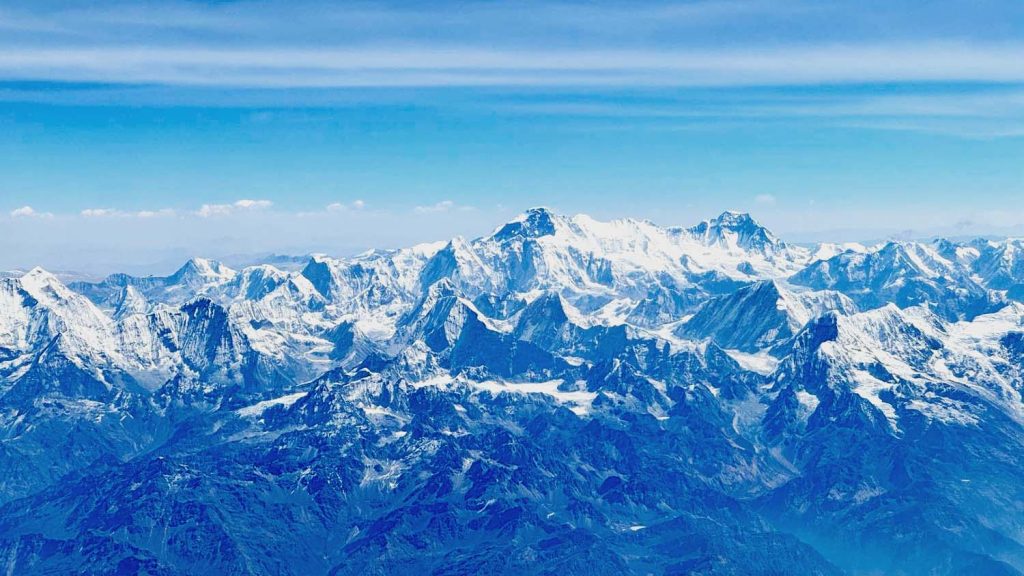
Photo by Julius Zetzsche via unsplash
Sherpas of Everest: The Backbone of Every Summit Success
When it comes to climbing Mount Everest, the spotlight often reaches the top of foreign climbers. But behind almost all successful climbs is a team of high-altitude heroes known as Sherpas. These mythological mountain guides are the backbone of the Himalayas campaigns, with unmatched physical ability, deep knowledge of mountains, and extraordinary flexibility.
Who is a Sherpa? Sherpa People History and Culture
Sherpa people on Mount Everest are an ethnic group that originated from the Himalayan region, mainly in Eastern Nepal. The term “Sherpa” is often misused to refer to any mountain guide, but it specifically refers to a separate ethnic society with Tibetan ancestry.
Cultural background
Sherpa means “People from the East” in the Tibetan language. 500 years ago, they migrated from Tibet to the Solukhumbu region in Nepal. Traditionally, they are Buddhists, with deep spiritual respect for the mountains, especially Sagarmatha (Everest), which they consider sacred.
Sherpa’s skills and roles in the Everest campaign
Climbing Everest is not possible without a Sherpa. They handle the most dangerous, demanding, and technical part of the campaign. Following are some of the Sherpa’s roles in the Everest campaign:
- Set and fix the ropes and ladder across the Khumbu icefall and crevasses.
- Carries the heavier load of oxygen, tent, fuel, food, and climbing gear -sometimes more than 20-30 kg at extreme heights.
- Guide the customers through the unpredictable terrain and monitor altitude sickness.
- Make multiple trips through dangerous areas such as the Khumbu icefall, often without oxygen.
Why are Sherpas so physically adapted?
Genetic adaptation allows them to be fitted at high altitudes with low oxygen levels. They even have better blood circulation, which helps them in better oxygen processing, resulting in strong lungs.
The Everest Trash Problem: Garbage, Waste, and Clean-Up Efforts
As the number of climbers on Mount Everest is increasing per day, the world’s highest mountain is facing a serious problem at the same time: garbage and pollution from human waste. Already nicknamed “The world’s highest garbage dump“, Mount Everest is now at the center of an environmental crisis that threatens the delicate ecosystem and the surrounding communities.
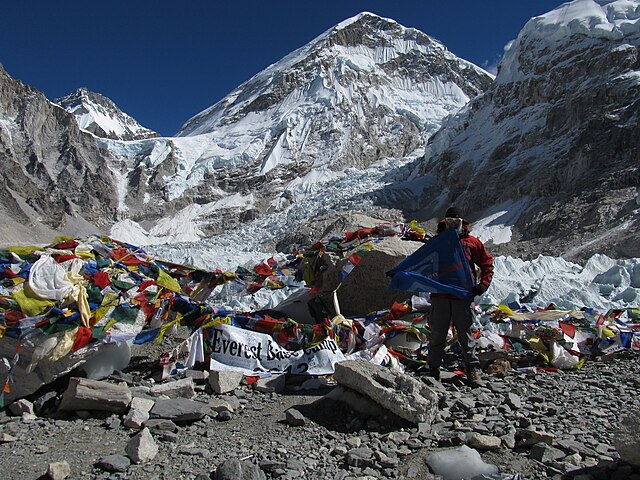
Photo by Robert Kern on Wikimedia Commons
Types of garbage left behind Mount Everest
Every year, hundreds of climbers and assistants climb Everest, carrying tons of garbage that is left behind at high altitudes, where cleanliness is almost impossible.
General garbage found on Everest:
- Used oxygen bottles
- Tents and sleeping bags
- Food wrappers
- Toilet paper and human waste
- Damaged climbing equipment
- Human corpse (left frozen at a high altitude)
Due to the difficulty of bringing the waste down from the death zone (over 8000 meters), most of this waste lasts for years, buried under snow and ice. Those buried decades before are now exposed due to melting glaciers.
Clean-up initiative on Everest: Eco Everest campaign and beyond
Recognizing the growing problem, several cleanliness stations have been launched to remove waste from Everest, including Sherpa, NGOs, and the Nepali army. Everest’s key cleanup efforts include:
- ECO Everest campaign (under the leadership of Dawa Steven Sherpa): This campaign was launched in 2008 and focuses on removing old waste and promoting responsible climbing on Everest. To date, about 25,000 kg (55,000 pounds) of trash has been removed from the mountain by this campaign.
- Sagarmatha Pollution Control Committee (SPCC): They have taken the responsibility of managing the waste below the base camp. They even run educational programs for trekkers and porters.
- Nepal Army Clean-Up Drive: They are a government-supported mission started in 2019, and the most effective one to date – removing 10+ tons of waste, including bodies and non-degradable waste of the Everest region.
Rules for waste deposits and Government regulations
To control the Everest waste problem, the Nepal government has introduced a set of strict environmental rules for climbers and campaign operators.
Current rules:
- $4000 refundable garbage deposits per team
- Mountain climbers must return with at least 8 kg of waste per person and their own equipment.
- Non-compliance leads to a fine
- Expedition must hire liaison officers for supervision
However, enforcement of these laws at great heights is still a challenge due to tough conditions and limited monitoring.
Everest Climb Statistics: Summits, Deaths, and Success Rates
Mount Everest Summit Data (AS 2024)
- Total Successful Climb: Over 13,150
- Unique climbers: around 7,100
- Most Climbed: Kami Rita Sherpa has summited Everest 31 times
- Youngest: Jordan Romero (13 years)
- Oldest: Yuichiro Miura (80 years)
Deaths on Mt. Everest
- Total Deaths: Over 330
- Average casualty rate: 1% climbers
- Most dangerous year: 1996 (15 deaths), 2014 (16 Sherpas killed), 2015 (22 Deaths)
Reason for death on Everest
- Avalanche: 35%
- Fall: 25%
- Frostbite: 10%
- Altitude sickness: 10%
- Exhaustion: 10%
- Crevasse Falls: 5%
- Unknown: 5%
Everest’s success rate per decade
- 2010-2020s: 60-65%
- 2000-2010s: 65%
- 1990-2000s: 34%
- 1980-1990s: 18%
- 1970-1980s: 21%
Mount Everest in Movies, Books, and Documentaries
Mount Everest has captured the imagination of filmmakers, writers, and content creators from all around the globe. There are hundreds of articles, books, films and documentaries published over the years. These have become a powerful source of inspiration, drama and controversy.
Popular movies about Everest
- Everest (2015): Based on the real-life 1996 disaster, the film follows the events that killed many climbers. With perfectly matched visual and emotional storytelling, this is one of the most famous Everest films.
- Thin Air (1997): A TV film, a conversion of John Krakauer’s bestselling book, which focuses on his personal account of the 1996 tragedy.
- Summit (2012): Although fully focused on K2, it draws several similarities with Everest.
Celebrated books and first-hand accounts
- Thin Air by John Krakauer: A recreation, first-person account of the Everest disaster of 1996. It is one of the most read and debated Everest books.
- The Climb by Anatoli Boukreev: Provides a different perspective on the 1996 tragedy, challenging Krakauer’s version.
- Touching My Father’s Soul by Jamling Tenzing Norway: Posted by the son of Tenzing Norgay, it combines history, spirituality, and personal reflection.
- No shortcuts to the top of Ed Viesturs: Accounts for a career of climbing the world’s highest peaks, including Everest, focusing on safety and strategy.
Best Documentaries on Everest
- Sherpa (2015): A powerful documentary that tells the story of Everest from the Sherpa’s perspective, focusing on the snowfall in 2014 icefall tragedy that killed 16 Sherpa.
- 14 Peaks: Nothing is impossible (2021): Following a Nepalese mountain climber, Nirmal Purja “Nims Dai”, who holds a record for summiting all the world’s 8000-meter peaks within 7 months.
Controversies on Everest: Overcrowding, Permits, and Ethics
Controversies on Everest are common. From ethical debates to logistical dilemmas, they keep arising over the years.
2019 “Traffic jam” tragedy
In May 2019, 11 climbers died due to the delay caused by overcrowding near the Summit. An image of a human traffic jam at the Hillary Step went so viral. And another reason was that the climbers were stuck in the Death Zone (> 8000 m). This gave a clear hint that the climbers had to wait for hours, which caused fatigue, cold, and altitude sickness, resulting in their death. This tragedy questions the regulation of the summit.
Limitations for climbers based on experience, age, and fitness
The debate is still there on who should be allowed to climb Everest. Climbers without prior climbing experience, those with medical limitations, and children are at higher risk. So, several proposals have been made:
- Mandatory proof of prior high-altitude experience (more than 6000 m peaks).
- The age limit (currently 16+ from the Nepal Side).
- Medical training certificate before approval of permits.
Future of Mount Everest: Climate Change and Regulation Challenges
Mount Everest today is praised as the symbol of challenge, discovery and natural surprise. But when we look ahead, the future of Mount Everest is quite uncertain. Pollution, climate change, and human behavior are reshaping what this iconic peak will look like in the coming years.
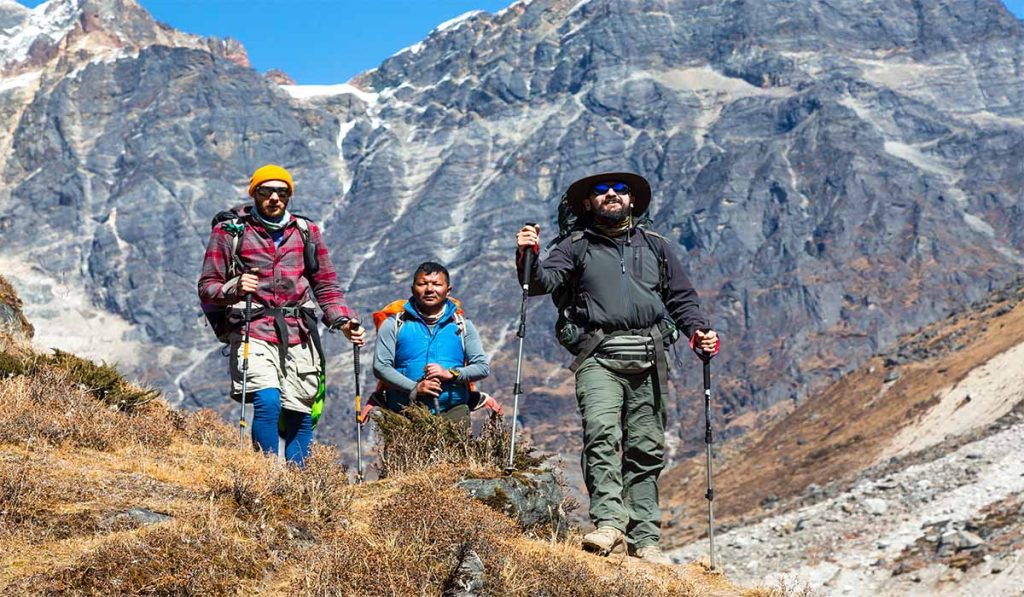
A changing landscape: climate and environmental changes
The most visible threat to Everest’s future is climate change. Rising global temperatures are melting the glaciers at a rapid rate. The glacier in the South Col, which is about 8000m+ in height, is losing ice at a pace that was unimaginable before. Researchers have even warned that the ongoing glacier melting will increase the avalanche risk, create new threats, and could even damage the trekking routes.
People and commercialization
Another factor that affects the future of Mount Everest is the increasing commercialization of climbing campaigns. In recent years, Everest has seen a record number of climbers during the climbing season.
If the trend continues, the mountain could withstand irreversible ecological damage, probably resulting in strong limitations or even a ban.
Technology and research role
The future of Mount Everest may also include advanced surveillance systems, real-time weather tracking, and AI-assisted security protocols. These technologies can reduce the risk of deadly falls and provide better environmental data to handle the delicate ecosystem in the mountains.
In addition, Everest has become a living laboratory to study the effects of high altitude and human adaptation. This scientific shape can shape the way of understanding and protecting the Earth’s ecosystem.
Will Everest be closed to tourists?
Hypothetical – but possible. There have been several temporary closures due to natural disasters (For example, earthquakes in 2015). Experts and environmental groups have been called up for strict permits, limits or seasonal bans. China (Tibet side) has already banned non-climbers from reaching advanced camps.
Mount Everest has become more popular for climbing, and it is important to protect both the mountain and the people living there. A permanent future for Everest means climbing with respect for nature, communities, and security.
Sustainable Future of Everest: What Responsible Climbing Might Look Like
It’s very critical to protect Everest and the people who live there, and that’s not difficult to understand for anyone who loves nature. For this, practicing responsible and sustainable climbing is a must. Here’s how it can be practiced:
- Allowing only experienced climbers with prior climbing experience can reduce accidents.
- An extra funding source, like an ECO permit or carbon tax, can support the conservation efforts.
- Stricter policies for personal and group waste removal to keep Everest clean.
- Limiting the daily climbers’ numbers to prevent human traffic jams at crucial places like the Death Zone.
- Solar energy, safe waste disposal policies, and environmentally friendly tents should be used in the base camps.
- Technology-driven approaches, like as GPS tracking and real-time weather updates to ensure safety.
Unknown Facts About Everest: Weird, Surprising, and Rarely Told
Mount Everest is known for its greatness and danger, but there are many low-composed, weird, and even terrible facts that will surely surprise you.
The Landmark Green Boots
One of the weirdest sites on Everest is “Green Boot”, where the body of an unknown climber wearing bright green boots has become a grim navigational marker over nearly two decades.
5G Internet in the base camp
In recent years, Everest Base Camp has been equipped with high-speed 5G Internet and Wi-Fi access. Mountain climbers can go live, update social media, and even tell their loved ones about being at the foot of the world’s tallest mountain.
Everest needs crowd control to prevent the deaths:
Apart from avalanches or weather, overcrowding is also one of the major factors causing death on Everest. Many of the climbers have to face death by waiting in line for too long at such extreme altitudes where oxygen is scarce and time is limited. To control this, Everest has a traffic management system that is responsible for managing the overcrowding.
The summit is not in Nepal:
Although most climbers are approaching Everest from Nepal, the real summit is exactly on the border between Nepal and China’s Tibet Autonomous Region. So, when you are at the top, you are technical in two countries at the same time.
The secret of 1924 remains unclear.
Decades before Hillary and Tenzing climbed Everest, British climbers George Mallory and Andrew Irwin tried to climb the summit in 1924. On June 8, 1924, they were seen on the northeast ridge of Everest just a few hundred meters from the summit. However, they never returned. Malori’s body was found in 1999, but there is still a debate about whether they reached the top before Tenzing and Hillary. If so, that probably made Tenzing and Hillary the first ones to return safely after reaching the peak.
This Everest’s slopes are Jumping Spiders’ home.
Euophrys omnisuperstes, or the jumping Spider, is found in cracks on the slope of the Everest at an altitude up to 6,700 meters. Surviving the temperature below zero degree, these insects made themself the highest permanent resident on Earth.
Final Thoughts: Why Everest Is More Than Just a Mountain
Mount Everest represents more than just the highest point on Earth. For some, this is a spiritual pilgrimage; for others, it is a goal of life. But above all, it is also a mirror that reflects our values, ambitions, and choices about the environment.
Everest teaches patience, humility, and boundaries of human ability. Nevertheless, as tourism and commercialization increase, Everest reminds us of our impact on the environment and the immediate need for being responsible before it’s too late.
Ultimately, Everest is not only a physical challenge, but also a symbol of global cooperation, environmental management, and a permanent sense of adventure.
Frequently Asked Questions (FAQs) about Everest
Is it safe to climb Mount Everest in 2026?
Climbing Everest is never entirely safe. It requires perfect planning with proper logistics, good fitness, the right training, experienced guides, and a determined team. Once you have that, you can take the risk to earn the supreme reward in the adventure field.
How long does it take to trek to the Everest base camp?
Trekking to the base camp ideally requires 10 to 14 days. However, it mostly depends on your pace and acclimatization. For general info, the ascending time is 8-9 days and 3-4 days for the descent.
What are the permit requirements for Mount Everest?
The permit requirement is something that can be changed at any time due to the growing debate on adding a Eco-permit for environmental conservation. However, as of 2025, Climbers need the following permits for the Everest expedition:
- Climbing Permit: $11,000 per climber
- Sagarmatha National park permit: $30 per trekker
- TIMS Card: $20
Do the climbers still find dead bodies on Everest?
Yes. Getting to see dead bodies is common on Everest. Due to the extreme cold and snow, the dead bodies do not decay. They just keep getting buried by the snow, and years later, when the ice melts or an avalanche brings them down, they get exposed. This is the same scenario happening today, as the bodies of climbers buried decades ago are now getting exposed.
Is the Summit push done at night? Why?
Yes. The final summit push is generally done at midnight. This allows the climber to reach the summit by morning when the weather is calm and the views are better. This also gives enough time to the climber and team to descend to a safer place before the afternoon storms.
What is the Human waste crisis on Everest?
At the base camp, you can find the eco-toilets or barrel toilets managed by the expedition team or the pollution control committee. However, when you move upwards to the advanced camps, getting toilets there is almost impossible, so climbers are guided to use ‘blue bags’ or ‘Wag bags’ for the collection of their excreta.
However, many climbers leave their waste behind, which gets accumulated and freezes in the cold. Due to this trend, tons of human waste have already accumulated on Everest, which are now getting exposed due to melting glaciers. This situation is called the human waste crisis on Everest.
How do climbers sleep at high altitudes?
Sleeping on Everest campaigns are often disrupted or broken due to extreme cold and suffocation. Because of this reason, many wear oxygen masks even while sleeping. Moreover, on reaching camp IV, which is in the Death Zone, you must not expect to rest for more than an hour, as only the final summit push keeps you apart from your dream of a lifetime.
What is the Rainbow Valley?
People might think that Rainbow Valley is a scenic place and is regarded colourful paradise when they hear the name. However, the name comes from the brightly coloured down jackets of the dead bodies that are still fresh, due to freezing temperatures. This place is in the ‘Death Zone’ where the bodies of unlucky climbers from centuries ago are still preserved.
